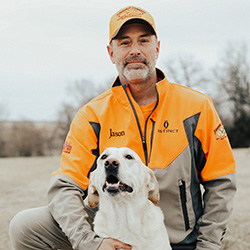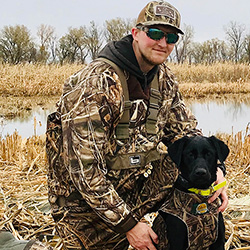Tips & Tricks from our waterfowl Guides
We are doing something a little different this week. One of my passions is waterfowl hunting. I don’t take time to do it as much as I would like but now that my boys are pestering me to go, I am going to have to schedule more hunts. We have sold quite a few waterfowl memberships this week. Our waterfowl memberships went down to $800 for a seat and there is no daily charge. You can bring youth at no extra charge and adult guests are $75/day if you want to bring your buddy along. We have a great group of guys joining this year and I have been down at the blind working this week. Our pro staff members Jason Christiansen & Andy Dunkle have been putting a lot of time in as well and we are excited for the season.
Below are the tips, tricks, and strategies to waterfowling from a couple of our waterfowl guides.
Jason Christiansen:

1. Weather changes/fronts: Many hunters get excited about hunting the day of the fronts or weather changes. Yes, I get it… they will move with cold, wind and snow/weather. Birds need water and fuel- if snow covers their food and freeze their water supply, they have to move. So when you get this weather north of you, everyone hunts the “hype day.” I would say the day before and the day after can be just as good. The day before, many times the birds will move ahead of the front and the day after you have trailing birds and birds that just arrived and need to feed and water after the travel. If the day after is a sunny blue bird sky, go try it.
2. Nature light and shadows- when you can use the sun light to your advantage: Just like us, waterfowl struggle to look right in to the sun, so if you can have the sun to your back, this is a double win- the birds can not see and you can hide in the shadows. If you can get a tree, bush, bale, bank, or whatever behind you to where no sun light is hitting you, you are as good as not even there!
3. Approach and landing spots: Watch birds and watch them in different winds and conditions. Think about how you want the birds to approach downwind or down current, and then think about what the birds are doing with the current weather conditions, location and how they are grouped up- small groups or larger. They need a place to land and that maybe behind or in front of your spread, set up with that in mind.
4. Call or do not call: I would say calling is your back up to your spread and your spot. If you are where the birds want to be and they are coming and making no noise, why call? Some people will call at every bird they see coming or going. Why? If you have birds coming to you from a distance and look to be set-up, let them come. Maybe, just maybe, give them a light quack or honk.
5. Hunting ice: If you have to hunt ice, look at the color of the ice and the breaks or openings. Birds want hard ice to land on and the do not like openings with jagged breaks around it.
6. Spinner placement: If I choose to use a spinner (although I have mixed feelings on these), I really struggle with having the spinner between me and the approach I have set-up for the birds. Birds will focus on the movement of the spinner and if you in the same line of sight there is a better chance they will see you. Put your landing zone and movement on either side of you or behind you.
7. Multiple callers: If there are going to be more than one person calling, do not mimic each other. It is best to have you and the others making different sounds at the same time than making the same sound at the same time.
Andy Dunkle:

1. Scouting, I would have to say, is the field or spot your hunting is one of the most important things to be mindful of. If you can, you want to be on the X. You should be under the flight of where the birds are going. Scouting can be how you make or break your hunt. Even if you’re hunting a pit blind hunting traffic birds, it still helps to scout out your birds to see how they are sitting in fields and loafing ponds. But hunting a traffic spot can be somewhat difficult.
2. The hide, in my opinion, even if your hunting the X and you’re not completely hidden. The birds will be out of there faster than you know. Natural vegetation out of the field or marsh your hunting is the best thing to hide with. The best thing to do while hiding blinds, is to over cover them. While coming in and out of blinds or layouts, you will knock your cover off and will not be hidden as well.
3. The decoys are very important to have- not only to look like a real bird, but you have to have your decoy spread look like a real flock. This comes from scouting the birds in your area and see if they are fairly spread out or packed in tight.
4. Calling, while you’re hunting where you scouted the birds out the night before. Your decoys are looking good and your blinds are hidden. You can ruin what seems to be a perfect set up by not sounding like a real flock of ducks and/or geese. This can happen by not calling quite enough or over-calling. You can learn how the birds are talking to one another by listening while you’re out scouting.
5. Calling the shot – one big thing I have learned over the years of hunting is not to second guess yourself on calling the shot. Almost 9 times out of 10, if you let them make one more pass, they usually drift off and not come into your decoys. I usually try to call the shot on the first or second pass the birds make if they are in good shooting range.
6. Your dog – having a good retriever is very crucial to most successful waterfowl hunts. Your dog will make retrieving your birds way easier and quite a bit faster than you doing the retrieving, and not to mention, you don’t get stuck out in the decoys while another flock of birds come in. You should try your best to teach your dog to be steady and not bolt when you come up to shoot. Dogs could get shot and killed or severely hurt by bolting. The other downside is that when your dog breaks before the birds are shot they will flare and make the shots harder.
7. Have a good time! You should always try to have a good time, even if the birds aren’t cooperating the way you would like. I personally enjoy every sunrise no matter what the outcome is. Another thing I love is watching mallards shine in the sun while they are swinging down into your decoys.
I really appreciate our Waterfowl Pro Staff and guide members. We didn’t get to interview all of them, but if you have any questions regarding our memberships or day hunts, please reach out. We are giving tours weekly until the season starts.
Here are some Updates at PB:
1.) Memberships are due September 1st! Click here to find out how you can become a member and what member benefits we offer including Waterfowl, Station Sponsors, and more!
2.) The Gun Dog Series is September 5th at 8am! Register by September 3rd.
3.) BOOK YOUR HUNT NOW, DATES ARE FILLING UP! Call 402-374-1765 to book!
4.) August 29th is our Member-Guest/Open House at Pheasant Bonanza! See Details in the flyer!
Words of Wisdom:
“Do not listen with the intent to reply but with the intent to understand.” – Unknown
“Be a good person but don’t waste time to prove it.” – Unknown
I hope you are working at your goals and putting in the work to get to your end work. As I have said before, I am a believer in accountability and if you have a small group with goals and a plan then you will push each other and call each other out when one is not putting in the “work”. I am doing well with my August challenge of 125 push ups, 125 sit ups, and 60 pull ups every day of the month. It’s crazy how much it is doing 60 pull ups, I usually do sets of 15 or 20 but when I started I was only doing sets of 5. It’s amazing what you have time for if you schedule it daily and have an accountability group checking in on you.
Are you “On Target”? Does your road map or plan match where you are wanting to go? Think about it and make the changes… you are the only one that can make it happen.
Best Regards,
Trent Leichleiter
Pheasant Bonanza
Managing Partner

